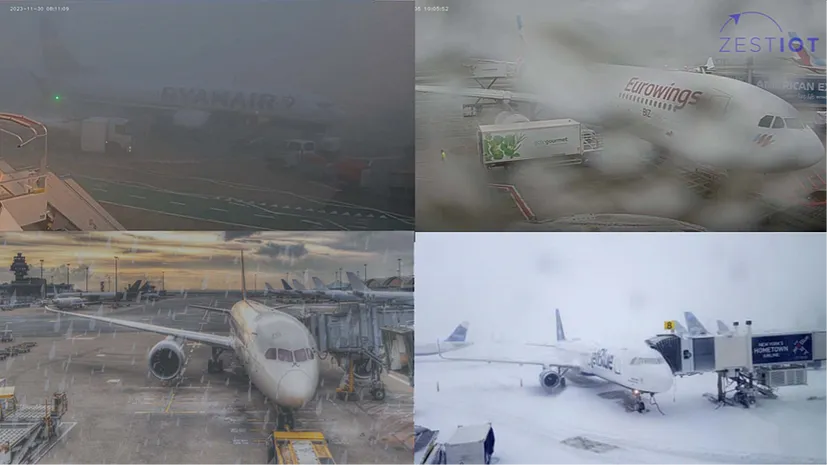With Google’s recent announcement of Gemini and the exciting advancements in open AI models, AI is poised to revolutionize every aspect of our lives. The aviation industry, like many others, is embracing the AI technology, and one particular area of focus is camera-based video analytics to acquire undisputable turnaround operations data without any manual intervention. CameraAI has become a buzzword in the industry, as it provides valuable intelligence with single source of truth enabling real time visibility of turnaround operations. The need for this technology has been recognized by airports, airlines, and the aviation community at large; but the crucial question still remains: Can Airport & Airlines operations adopt it for day-to-day operational decisions?
Main challenge in implementing Camera AI based systems in complex and intensive operations, such as flight operations at a busy hub airport with over 1000 air traffic movements, is reliability in all weather conditions. While the aviation has successfully pilot the technology & is very bullish about possibilities of AI technology for acquiring non-disputable data, such as aircraft turnaround information; making it work in all weather conditions to achieve 100% reliability still poses significant challenges. Adverse weather conditions impact airport operations significantly as recently experienced by Munich Airport. Need for accurate & reliable system providing complete visibility of operations to recover from disruptions is very critical for airports.

Three key factors present hurdles for the aviation industry to fully adopt video analytics AI technology in their operational processes.
- Extreme weather conditions, such as fog or sandstorms
- Rain and dust conditions
- Blind spots or occlusions of objects that cameras cannot see
According to a recent statement from an airport’s chief operating officer, the AI system performs well under ideal conditions, such as on sunny days. However, this does not reflect the reality at the airport. Operations cannot rely on a system that only works in ideal conditions. Due to these factors, AI systems based on camera feeds fall short of expectations. As a result, the aviation industry has not been able to fully embrace AI technology for operational purposes beyond pilot projects.
It is clear that improving the reliability of AI systems in challenging operational environments is crucial for the widespread adoption in the aviation industry. Addressing issues related to extreme weather conditions, delayed detections, and blind spots will be essential to overcome this hurdle and enable the full potential of AI technology in aviation operations. But is there a solution to overcome this?
Yes: The potential of IoT sensors technology combined with the advancement of small IoT chips has been largely untapped in such scenarios. Leading consulting firms like Deloitte has published exhaustive case studies of IoT applications for airport. While GPS based telematics data has been in existence since last 30 years, advancement of IoT devices with GPS & other sensors has been widely adopted in industrial harsh operating environments. These sensors and IoT devices have the capability to generate significant amounts of data, operating continuously in harsh environments without being affected by extreme weather conditions such as rain or dust. Unlike camera AI technology, which is often constrained by these factors, sensors and IoT can operate effectively in such weather or extreme operating environment conditions. Lidar is another alternative technology which can be very instrumental in such scenarios. However cost may be prohibitive for return on investment. A robust system will need multiple technologies & data sources to provide a reliable undisputed data acquisition for Aircraft turnaround operations.
Some airports have embraced this idea and conducted trials by integrating IoT data along with CameraAI based video analytics into their turnaround processes. The main challenge was to ensure reliable data collection in zero-degree temperatures and foggy conditions. Early results from technology trials are very promising:

Impact of IoT sensors based additional data & improvement in operations detection
One important finding from these pilot program was that out of the 60-plus operations to be detected by Camera, 39 operations utilised IoT sensors technology as an additional source of operations data. This led to a significant increase in the reliability of the system’s capture rate, from 75% to over 95%, particularly in extreme weather, occlusion and low-light conditions.
An example of using IoT sensors is arrival of Baggage Freight Loader (BFL) to the ramp serving bay. On arrival of aircraft, BFL connects to the belly of aircraft once aircraft front or rear hold is open. Once the loading & unloading is finished, BFL disconnects from the aircraft & often leave the ramp area to serve other flights:

E.g. Acquisition of Baggage Freight Loader operations for a flight using IoT & sensors
Results of the pilot with initial outcomes have been extremely positive for European airport. From the pilot, it is evident that for Airport operations to rely on AI technology, system must deploy additional sources of data to provide reliable way of acquiring turnaround operations data in all weather conditions. This also becomes a foundation for accurate prediction of TOBT which is very important outcome Euro Control is focussing on through Airport Operations plan.
Some airports are taking this thought further to integrate all data sources involving above the wing, below the wing, aerobridge with important roles performing various operations around the aircraft without compromise on privacy with integration of equipments & operations as well as data from various system sources to create a true digital twin of Aircraft turnaround operations.

#ConnectToTransform #CameraAI #IoT #TurnTracking #AircraftDigitalTwin #Reliability #DataDrivenDecisions #newtechnologies #AI #artificialIntelligence #IOT #autonomoustechnology #aviation #airport #airlines #groundhandling #paperless #turnaroundmanagement #turnaround #deeptech #deeptechstartups #ZestIoT #GroundRadarConnectedOperations #AviationInnovation #AircraftTurnDigitalTwin #TurnTrackingDigitalTwin #DigitalTransformation #BusinessROI #DefinitiveROI #Innovation #SmartAviation

